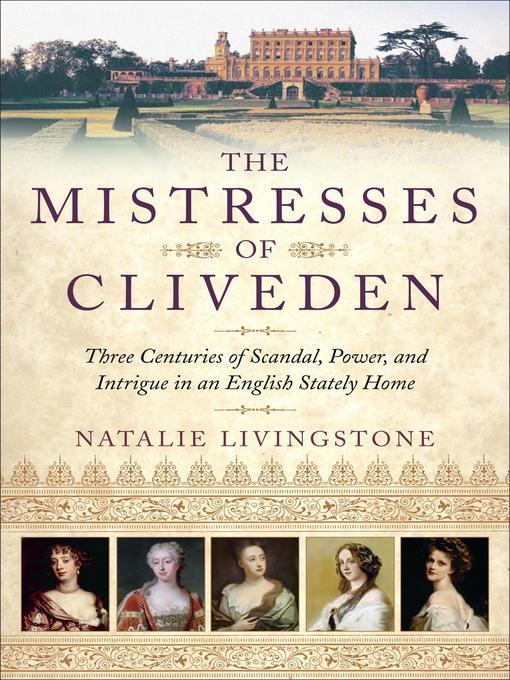
The Mistresses of Cliveden
Three Centuries of Scandal, Power, and Intrigue in an English Stately Home
کتاب های مرتبط
- اطلاعات
- نقد و بررسی
- دیدگاه کاربران
نقد و بررسی

March 28, 2016
This lively, accessible work from English writer Livingstone follows five mistresses of Cliveden from the time of late-17th-century Restoration-era rakes to the swinging 1960s. Anna Maria, Countess of Shrewsbury, and Elizabeth, Countess of Orkney, were louche paramours of prominent noblemen. Augusta, Princess
of Wales, was the wife of a progressive but doomed heir. Harriet, Duchess of Sutherland, was a do-gooder and close friend of Queen Victoria. The last mistress, American-born Nancy Astor, became the first woman elected to Parliament. Her son presided over the estate’s most notorious modern scandal, 1963’s Profumo Affair, when Britain’s war minister shared the charms of party girl Christine Keeler with a possible Soviet spy. Cliveden flourished as a center of hedonism, culture, and politics. King George III, who aroused the ire of American colonists, spent a portion of his childhood there. Guests included Jonathan Swift, William Gladstone, and Lawrence of Arabia. Downton Abbey this is not: it traces the saga of unrelated women, not a single aristocratic family. Sutherland and Astor truly influenced history; other women of Cliveden were activists, and all chafed under the restrictions imposed on women. Packed with details about architecture, gardens, clothing, and manners, Livingstone’s debut is an entertaining, anecdotal popular history. Photos.

April 1, 2016
A series of biographies of the women connected to Cliveden, the house made famous in the Profumo affair. The first, Anna Maria (1642-1702), was widowed when her lover, the Duke of Buckingham, killed her husband in a duel in 1668. Scandal was a way of life in Restoration England, and Anna Maria eventually moved into Buckingham's London home--with him and his wife. By the time Cliveden was completed, they had separated. Elizabeth Villiers, a cousin to Buckingham, was educated with two of James II's daughters, Mary and Anne. Elizabeth accompanied Mary when she married William of Orange and promptly had an affair with him. After Queen Mary's death, William granted Irish estates to Elizabeth that made her the richest woman in England, which made for a convenient marriage to the Earl of Orkney and life at Cliveden. Orkney's heir leased the property to Frederick, Prince of Wales, and his successful marriage to Augusta of Saxe Gotha proved to be a contrast to the rigidity of the court. Harriet, raised at Castle Howard and a great friend of Queen Victoria, married the even wealthier Duke of Sutherland. Together, they created a calm retreat at Cliveden where Victoria often came for walks on the grounds. Harriet was also a prolific political and social campaigner, and she fought against slavery in the United States. Throughout its history, Cliveden was a haven for great minds, and famous guests were the norm for all the women of Cliveden. Nancy Astor (1879-1964) was an acerbic, quick-tempered woman. Like her predecessors, she changed conceptions of female power and served as a member of Parliament for 25 years. She made Cliveden a symbol of highly politicized forms of power, class and ideology. In her debut book, Livingstone ably avoids tabloidlike gossip to profile five remarkable women, and she provides a helpful cast of characters at the beginning of the story. Readers who enjoy English history will be happy to have this in their libraries.
COPYRIGHT(2016) Kirkus Reviews, ALL RIGHTS RESERVED.

April 15, 2016
Journalist and debut author Livingstone examines the lives of five memorable women, from Anna Maria Talbot in the 17th century to Nancy Astor in the 20th, and the mansion that connects them. As the current "mistress of Cliveden," the author's passion for the subject comes through in her extensive research, providing a thorough look at the drama involving these figures. The book not only delves into their varying roles in English society but uses their stories to craft the estate's history as well. However, Livingstone's commitment to encapsulating the goings-on of the period can confuse the narrative, in places taking attention away from the women's compelling struggles and triumphs in order to describe Cliveden's features or introduce concurrent events happening at the time. Whereas books such as John Martin Robinson's Requisitioned: The British Country House in the Second World War offer overviews of houses and their relevance to historical occasions, this work uniquely approaches the background of a single residence and the tremendous women who occupied its rooms. VERDICT Lovers of modern English history and the scandals that infiltrated upper-crust society will find much to enjoy in this work.--Katie McGaha, County of Los Angeles P.L.
Copyright 2016 Library Journal, LLC Used with permission.

























دیدگاه کاربران